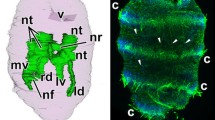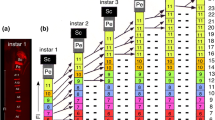Summary
-
1.
Small pieces of ectoderm were excised from gastrulae, neurulae, and tailbud embryos ofXenopus laevis andTriturus alpestris, preserved inLehmann's fixatives, sectioned at 0.025–0.75μ, and photographed with a Trüb-Täuber electron microscope.
-
2.
The following features characterize the early gastrular ectoderm: endoplasmic reticulum coarse, vesicular, and predominantly loose; mitochondria mostly globular and irregular; lipoid droplets and yolk-platelets with investing plasma membranes; pigment granules ofTriturns, but not ofXenopus, composed of subunits; nuclei polymorphic, especially inTriturus, with deep infoldings of nuclear membrane; cells frequently connected only by cytoplasmic bridges which may be anastomosed, cells otherwise separated by spaces or canals.
-
3.
Presumptive medullary plate from the very early neurula shows certain differences from the above features: endoplasmic and nuclear reticula considerably more dense; cytoplasmic vesicles, fibers, and granules more delicate; mitochondria smooth and rod-like with increased number of cristae; intercellular spaces less prominent, except between presumptive neural plate and chordamesoderm, the cytoplasmic processes of which may anastomose.
-
4.
Presumptive epidermis of the very early neurula shows a wide meshed fibrous reticulum and distally situated mitochondria, foreshadowing the development of highly differentiated outer zones in the epidermal cells of the tailbud embryo.
-
5.
Mitochondria of neural cells of the late tailbud embryo are predominantly perinuclear, quite elongate, relatively narrow, and possess many thin longitudinally or diagonally placed cristae.
-
6.
Mitochondria of the tailbud epidermis are shorter and thicker than those of the neural tube cells, exhibit pores and swollen tubules, and occur in large numbers below a distal zone of dense cytoplasmic reticulum and secretory vesicles, which seem to form in waves and to discharge periodically their secretion to the surface of the skin.
-
7.
The concept of mitochondrial “differentiation” is further developed and the function of epidermal mitochondria and the importance of intercellular contacts, especially in relation to neural induction, are discussed.
Similar content being viewed by others
References
Afzelius, B. A.: The ultrastructure of the nuclear membrane of the sea urchin oocyte as studied with the electron microscope. Exper. Cell Res.8, 147–158 (1955).
Andres, G., A. Bretscher, F. E. Lehmann u.D. Roth: Einige Verbesserungen in der Haltung und Aufzucht vonXenopug laevis. Experientia (Basel)5, 83–84 (1949).
Bairati, A., undF. E. Lehmann: Über die Feinstruktur des Hyaloplasmas von Amoeba proteus. Rev. suisse Zool.58, 443–449 (1951).
—: Über die submikroskopische Struktur der Kernmembran beiAmoeba proteus. Experientia (Basel)8, 60–61 (1952).
—: Partial disintegration of cytoplasmic structures ofAmoeba proteus after fixation with osmium tetroxide. Experientia (Basel)10, 173–175 (1954).
Barth, L. G., andL. Jaeger: The role of adenosinetri-phosphate in phosphate transfer from yolk to other proteins in the developing frog egg. I. General properties of the transfer system as a whole. J. Cellul. a. Comp. Physiol.35, 413–436 (1950).
Boell, E. J., andR. Weber: Cytochrome oxidase activity in mitochondria during amphibian development. Exper. Cell Res.9, 559–567 (1955).
Callan, H. G., andS. G. Tomlin: Experimental studies on amphibian oocyte nuclei I. Investigation of the structure of the nuclear membrane by means of the electron microscope. Proc. Roy. Soc. Lond., Ser. B137, 367–378 (1950).
Dollander, A.: La structure du cortex de l'oeuf de Triton observée sur coupes fines et ultrafines au microscope ordinaire, et au microscope électronique. C. r. Soc. Biol. Paris148, 152–154 (1954).
Farquhar, M. G.: Preparation of ultrathin tissue sections for electron microscopy. Labor. Invest.5, 317–337 (1956).
Fischer, F. G., andH. Hartwig: Die Vitalfärbung von Amphibienkeimen zur Untersuchung ihrer Oxydation-Reduktions-Vorgänge. Z. vergl. Physiol.24, 1–13 (1936).
Glaesner, L.: Normentafeln zur Entwicklungsgeschichte des gemeinen Wassermolchs (Molge vulgaris). Jena: Gustav Fischer 1925.
Haguenau, F., etW. Bernhard: Particularités structurales de la membrane nucléaire. Bull. Cancer (Paris)42, 537–544 (1955).
Kemp, N. E.: Electron microscopy of growing oocytes of Rana pipiens. J. of Biophys. a. Biochem. Cytology2, 281–292 (1956).
King, T. J., andR. Briggs: Changes in the nuclei of differentiating gastrula cells, as demonstrated by nuclear transplantation. Proc. Nat. Acad. Sci. U.S.A.41, 321–325 (1955).
Lehmann, F. E.: Die submikroskopische Organisation der Zelle. Klin. Wschr.1955, 294–300.
—: Der Feinbau von Kern und Zytoplasma in seiner Beziehung zu generellen Zellfunktionen. Ergebnisse der medizinischen Grundlagenforschung. Stuttgart: Georg Thieme 1956.
Lehmann, F. E., u.R. Biss: Elektronenoptische Untersuchungen an Plasmastrukturen des Tubifex-Eies. Rev. suisse Zool.56, 264–269 (1949).
Lehmann, F. E., andV. Mancuso: Improved fixative for astral rays and nuclear membrane of Tubifex embryos. Exper. Cell Res.13, 161–164 (1957).
Lehmann, F. E., andH. R. Wahli: Histochemische und elektronenmikroskopische Unterschiede im Cytoplasma der beiden Somatoblasten des Tubifexkeimes. Z. Zellforsch.39, 618–629 (1954).
Nieuwkoop, P. D., andJ. Faber: Normal table of Xenopus laevis (Daudin). Amsterdam: North-Holland Publishing Co. 1956.
Weber, R.: Strukturveränderungen an isolierten Mitochondrien vonXenopus-Leber. Z. Zellforsch.39, 630–640 (1954).
—: Zur Verteilung der Mitochondrien in frühen Entwicklungsstadien vonTubifex. Rev. suisse Zool.63, 277–288 (1956).
Weber, R., u.E. J. Boell: Über die Cytochromoxydaseaktivität der Mitochondrien von frühen Entwicklungsstadien des Krallenfrosches (Xenopus laevis Daud.). Rev. suisse Zool.62, 260–268 (1955).
Weissenfels, N.: Über die funktionelle Entleerung, den Feinbau und die Entwicklung von Tumor-Mitochondrien. Z. Naturforsch.12b, 168–171 (1957).
Wohlfarth-Bottermann, K. E.: Cytologische Studien. IV. Die Entstehung, Vermehrung und Sekretabgabe der Mitochondrien vonParamaecium. Z. Naturforsch.12b, 164–167 (1957).
Author information
Authors and Affiliations
Additional information
The senior author acknowledges with appreciation the fellowship assistance of the National Science Foundation, a sabbatical leave from the University of California, and the cordial hospitality of the Zoological Institute of the University of Bern and of its Director, ProfessorLehmann. We are indebted to Madame Y.Roulet of the Department of Electronmicroscopy of the Chemical Institute of the University of Bern for assistance in the electronmicroscopy and to Dr.Rudolf Weber for a critical reading of the manuscript
Rights and permissions
About this article
Cite this article
Eakin, R.M., Lehmann, F.E. An electronmicroscopic study of developing amphibian ectoderm. W. Roux' Archiv f. Entwicklungsmechanik 150, 177–198 (1957). https://doi.org/10.1007/BF00576820
Received:
Issue Date:
DOI: https://doi.org/10.1007/BF00576820




